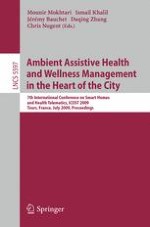2009 | Book
Ambient Assistive Health and Wellness Management in the Heart of the City
7th International Conference on Smart Homes and Health Telematics, ICOST 2009, Tours, France, July 1-3, 2009. Proceedings
Editors: Mounir Mokhtari, Ismail Khalil, Jérémy Bauchet, Daqing Zhang, Chris Nugent
Publisher: Springer Berlin Heidelberg
Book Series : Lecture Notes in Computer Science
